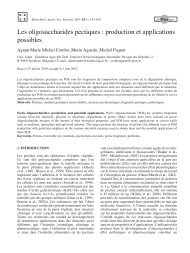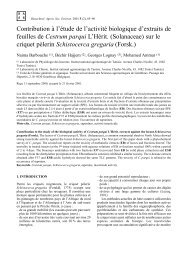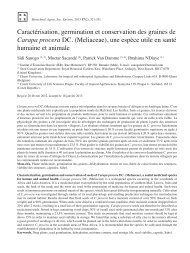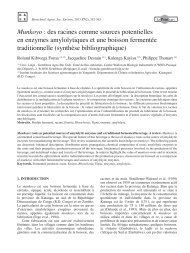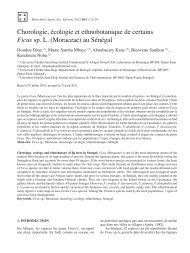Culture of Spirogyra africana from farm ponds for long- term ...
Culture of Spirogyra africana from farm ponds for long- term ...
Culture of Spirogyra africana from farm ponds for long- term ...
Create successful ePaper yourself
Turn your PDF publications into a flip-book with our unique Google optimized e-Paper software.
428 Biotechnol. Agron. Soc. Environ. 2013 17(3), 423-430 Gallego I., Casas J.J., Fuentes-Rodriguez F. et al.filaments were higher in this medium compared to theothers. This can be explained by the difference in thenutrient composition <strong>of</strong> the three culture media tested,particularly their contrasting N:P molar ratios, sinceboth are essential macronutrients <strong>for</strong> algal primaryproduction (Sterner et al., 2002; Klausmeier et al.,2004). In the field, a high growth <strong>of</strong> the <strong>Spirogyra</strong>fluviatilis Hilse complex was reported after fertilizingwith a molar ratio N:P = 10:1 (Townsend et al., 2008).This approaches the HSCHU#10 <strong>of</strong> our experiments(N:P = 8.5:1) and both are relatively close to the optimalRedfield ratio <strong>of</strong> 16:1 proposed <strong>for</strong> phytoplankton(Klausmeier et al., 2004). However, the N:P supplyratios <strong>of</strong> FPW and sD11 significantly deviated <strong>from</strong>the ratio both Redfield ratio and the ratio proposed byTownsend et al. (2008), pointing respectively to a case<strong>of</strong> P- and N- impoverished media.<strong>Spirogyra</strong> <strong>africana</strong> mats grew in the pond withapparently no nutrient limitations during the 10 weeks<strong>of</strong> our experiment (I. Gallego, unpubl. data) while FPWshowed the poorest result. It is likely that the sedimentwas an important P source <strong>for</strong> this benthic alga in thenatural system (Townsend et al., 2008). The extremelylow-P FPW probably resulted in a severe nutrientdepletion in our experiment, where the pond sedimentwas not included.Contrary to our expectations, S. <strong>africana</strong> filamentsdid not grow in sD11 and the percentage <strong>of</strong> livefilaments was relatively low. The specific sD11 mediumhas been reported as a successful medium to grow<strong>Spirogyra</strong> spp. in vitro cultures (Graham et al., 1995;O’Neal et al., 1995; Berry et al., 2000). However, weobtained poorer results with this medium comparedto HSCHU#10, a medium commonly used on a widerange <strong>of</strong> algae (Saygideger, 1996). Our experimentalconditions were similar to those used previously with<strong>Spirogyra</strong> spp. growing in sD11, i.e. temperature,irradiance and a weekly medium replacement.However, our experiment lasted <strong>for</strong> 10 weeks and halfthe medium was replaced weekly, whilst previous oneslasted only <strong>for</strong> 2-3 weeks (O’Neal et al., 1995; Berryet al., 2000) and media were entirely replenished every7-10 days (Berry et al., 2000). The effect <strong>of</strong> N depletionon S. <strong>africana</strong> growth became evident several weeksafter inoculation in sD11, while filaments in short-<strong>term</strong>cultures could thrive <strong>for</strong> a while on cellular N reserves.Our results show that despite the reportedly goodresults <strong>of</strong> the specific sD11 medium <strong>for</strong> S. <strong>africana</strong>cultures, filament growth <strong>for</strong> <strong>long</strong>-<strong>term</strong> cultures is notguaranteed.Indeed, mat cohesiveness was studied by Berryet al. (2000) as an indicator <strong>of</strong> filament decline thatdepends on irradiance. A higher filament entanglementwas observed in our sD11 replicates than in FPW andHSCHU#10 (data not shown), despite all our replicateswere exposed to the same irradiation. We suggest thatcohesiveness may be also dependent on the mediumnutrient content as well, although further study isrequired in this area.Since there is a lack <strong>of</strong> studies on irradiance and/or temperature using other culture media apart <strong>from</strong>sD11, we can only suggest that the observed matcohesiveness and the low-N composition <strong>of</strong> sD11 maybe detrimental <strong>for</strong> S. <strong>africana</strong> survival.The conditions <strong>for</strong> avoiding nutrient depletionin our experiment (weekly replacement <strong>of</strong> half themedium) were clearly insufficient in sD11 and FPW,but seemed to be adequate in HSCHU#10. Indeed, theeffect <strong>of</strong> mat cohesiveness may interact with nutrientcomposition and nutrient depletion. Thus, <strong>long</strong>-<strong>term</strong>cultures can be per<strong>for</strong>med in HSCHU#10 with lesslaboratory manipulation and ef<strong>for</strong>t, so we recommendthis medium <strong>for</strong> <strong>long</strong>-<strong>term</strong> experiments or <strong>for</strong> themaintenance <strong>of</strong> stock cultures <strong>of</strong> S. <strong>africana</strong>.Effectiveness <strong>of</strong> chlorination on S. <strong>africana</strong> growth.Chlorination had a positive effect on filaments growth,while the effect <strong>of</strong> chlorination on the percentage <strong>of</strong>live filaments was only significant when interacted withtime. Chlorine is reported as a traditional sterilizingagent <strong>for</strong> removing epibionts <strong>from</strong> macroalgae(García-Jiménez et al., 1999; Pang et al., 2007) and freechlorine also inactivates bacteria and cyanoprokariota(Daly et al., 2007; Amiri et al., 2010). The elimination<strong>of</strong> these nutrient competitors by chlorination probablyfavored <strong>Spirogyra</strong> growth. In spite <strong>of</strong> this apparentlypositive effect, sodium hypochlorite can react withpolysaccharides present in the mucilaginous sheath<strong>of</strong> the Zygnemataceae (Cheli et al., 1989) and evendamage the cell walls. Thus, the higher mortalityobserved in chlorinated samples at the beginning <strong>of</strong>the experiment could be attributed to this treatment.However, at the end <strong>of</strong> the experiment, this likelydamage might be counteracted by the elimination <strong>of</strong>competitors.4.2. Rhizoid genesis in S. <strong>africana</strong>Our results on rhizoid production are not as clear asthose on growth and percentage <strong>of</strong> live filaments.The N:P ratio does not seem to be involved in rhizoidproduction, since both HSCHU#10 and FPW showedsimilar results. A low extracellular Ca 2+ concentrationand release <strong>of</strong> single cells have also been reported astriggering factors <strong>of</strong> rhizoid <strong>for</strong>mation (Nalewajkoet al., 1989; Ikegaya et al., 2004). Nonetheless, thelowest concentration <strong>of</strong> Ca 2+ occurred in HSCHU#10,which showed high rhizoid <strong>for</strong>mation, while singlecells released <strong>from</strong> filaments were observed in bothsD11 and FPW (I. Gallego, unpubl. data), whichparadoxically showed different results. We suggestthat other unidentified factors, not described in the



